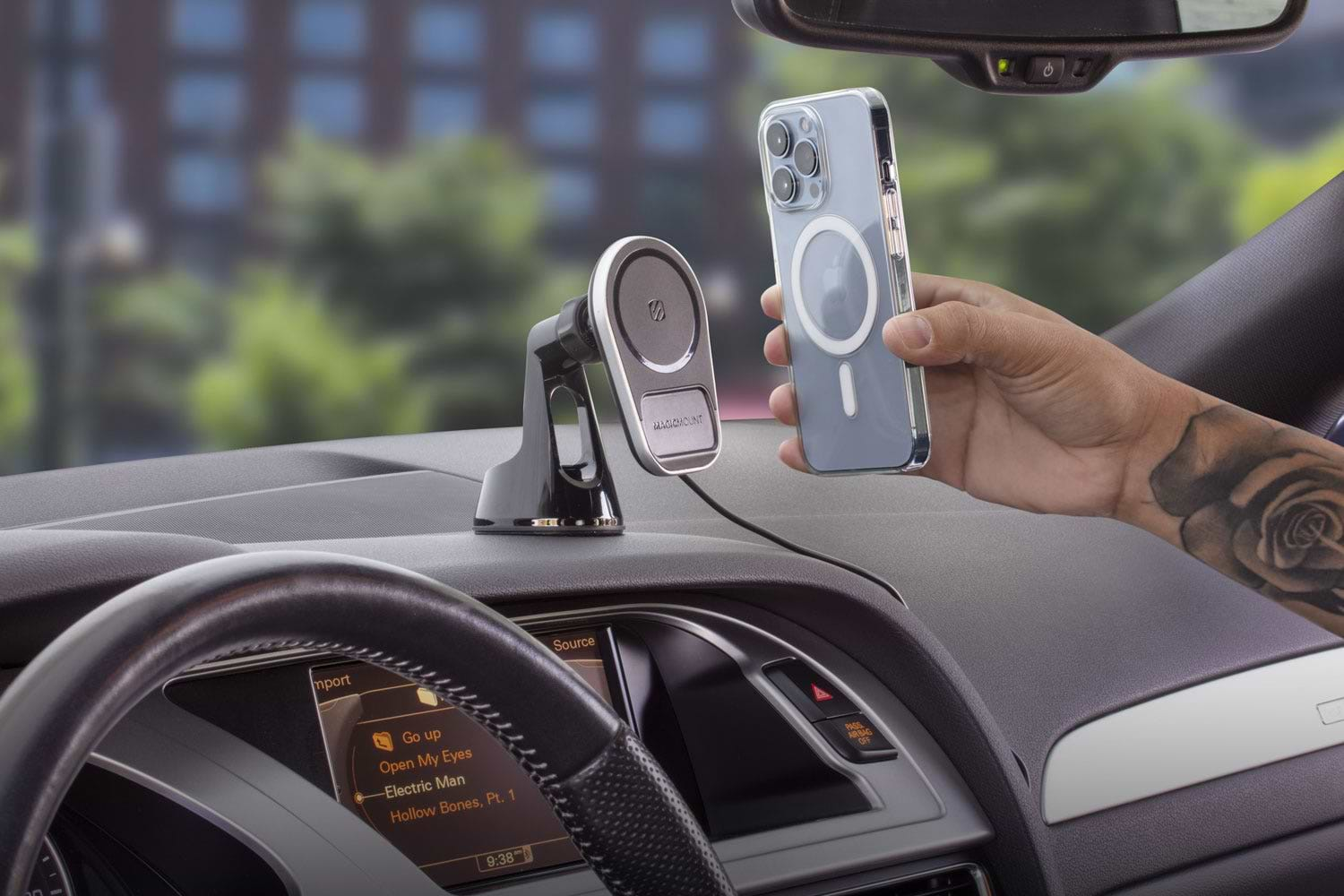Wireless Charging Demystified: How It Works

Wireless charging has become increasingly popular in recent years, offering a convenient and efficient way to power our devices. But how does it actually work?
In this article, we will explore the concept of wireless charging, explore the different types available, and analyze the pros and cons of this innovative technology.
So, let's demystify wireless charging and gain a deeper understanding of its inner workings.
Understanding the Concept of Wireless Charging
Wireless charging, also known as inductive charging, is a method of transferring power from a power source to a device without the need for physical connections. Instead of using traditional wired chargers, wireless charging relies on electromagnetic fields to transmit energy.
Imagine a world where you no longer have to deal with tangled cords and limited charging ports. With wireless charging, you can simply place your device on a charging pad or dock, and it will start charging automatically. This technology has revolutionized the way we power our devices, making charging more convenient and hassle-free.
The Science Behind Wireless Charging
At the core of wireless charging is the principle of electromagnetic induction. This phenomenon occurs when a changing magnetic field generates an electric current in a conductor placed within the field. Wireless chargers utilize coils of wire to create alternating magnetic fields, inducing a current in a receiving coil within the device.
Let's dive deeper into the science behind wireless charging. When an alternating current (AC) passes through the transmitting coil in the charging pad or dock, it generates a magnetic field. This magnetic field then interacts with the receiving coil inside the device, creating a flow of electricity that charges the battery.
It's fascinating to think about how this technology harnesses the power of magnetic fields to transfer energy wirelessly. The coils in both the charging pad and the device are carefully designed to optimize the efficiency of power transfer, ensuring that the charging process is as quick and effective as possible.
The Evolution of Wireless Charging Technology
Wireless charging technology has come a long way since its inception. Initially, it was limited to low-power devices such as electric toothbrushes and medical implants. However, with advancements in technology, wireless charging has expanded its horizons and is now capable of efficiently powering smartphones, tablets, and even electric vehicles.
One of the major breakthroughs in wireless charging technology was the introduction of the Qi standard. Qi, which means "energy flow" in Chinese, is a global standard for wireless charging. It ensures compatibility between different devices and charging pads, allowing for seamless charging experiences across various brands and models.
As wireless charging continues to evolve, researchers are exploring new ways to enhance its capabilities. For example, there are ongoing efforts to develop wireless charging technologies that can transmit power over longer distances, enabling devices to charge even when they are not in direct contact with a charging pad.
Moreover, companies are also working on integrating wireless charging capabilities into everyday objects, such as furniture and vehicles. Imagine having a coffee table that can wirelessly charge your phone or a car that charges itself while you drive. These advancements have the potential to transform the way we interact with technology and make our lives more convenient.
In conclusion, wireless charging is a remarkable technology that allows us to power our devices without the need for physical connections. Through the principles of electromagnetic induction, wireless chargers transmit energy through magnetic fields, enabling efficient and convenient charging. As this technology continues to evolve, we can expect to see even more innovative applications and advancements in the world of wireless charging.
The Mechanics of Wireless Charging
Now that we understand the underlying principles, let's delve into the mechanics of wireless charging and explore how it actually works.
Wireless charging, also known as inductive charging, is a technology that allows devices to charge without the need for physical connections. It has gained popularity in recent years as a convenient and hassle-free way to power up our devices.
The Role of Electromagnetic Fields
As mentioned earlier, wireless charging relies on electromagnetic fields to transfer power. The charging pad or dock contains a transmitting coil that generates an alternating magnetic field when connected to a power source. This field then induces a current in the receiving coil within the device.
The concept of using electromagnetic fields for power transfer dates back to the 19th century when scientist Nikola Tesla conducted experiments on wireless power transmission. His groundbreaking work laid the foundation for the development of wireless charging technology as we know it today.
It is important to note that the distance between the transmitting and receiving coils affects the efficiency of wireless charging. As the distance increases, there may be a drop in power transfer due to the decrease in magnetic field strength. However, advancements in technology have minimized this limitation, allowing for more efficient wireless charging over longer distances.
The Process of Energy Transfer
The energy transfer process in wireless charging involves three main stages: resonance, transmission, and reception.
During the resonance stage, the transmitting and receiving coils are tuned to resonate at the same frequency. This ensures maximum power transfer between the two coils. Resonance is a phenomenon where an object vibrates at its natural frequency when exposed to an external force of the same frequency. By achieving resonance, the efficiency of power transfer is greatly enhanced.
Once resonance is achieved, the transmission stage begins. The transmitting coil in the charging pad or dock generates an alternating magnetic field, which induces an alternating current in the receiving coil inside the device. This current is then rectified and used to charge the device's battery.
The process of rectification involves converting the alternating current into direct current, which is the type of current used to charge batteries. This conversion is necessary because most electronic devices, such as smartphones and tablets, require direct current to operate and charge their batteries effectively.
Finally, during the reception stage, the device's battery receives the transferred energy and stores it for later use. The charging process continues until the battery reaches its full capacity or the user removes the device from the charging pad.
Wireless charging technology has come a long way since its inception. Today, it is not only used in smartphones and tablets but also in various other devices such as smartwatches, earbuds, and even electric vehicles. The convenience and flexibility offered by wireless charging have made it a popular choice among consumers worldwide.
As technology continues to advance, we can expect further improvements in wireless charging efficiency, range, and compatibility. The future of wireless charging looks promising, with the potential to revolutionize the way we power our devices.
Different Types of Wireless Charging
Wireless charging technology offers several different methods to cater to varying needs and preferences. Let's explore some of the most common types of wireless charging:
Inductive Charging
Inductive charging is the most widely adopted form of wireless charging. It utilizes magnetism and electromagnetic fields to transfer power. The primary coil in the charging pad creates a magnetic field, inducing a current in the secondary coil within the device. This type of wireless charging is commonly found in smartphones, smartwatches, and other small electronic devices.
Resonant Charging
Resonant charging takes wireless charging a step further by using resonant inductive coupling. It involves the use of two resonant coils - one in the charging pad and the other in the device. These coils are tuned to resonate at the same frequency, allowing for efficient power transfer over greater distances. Resonant charging is suitable for charging multiple devices simultaneously and is commonly used in wireless charging pads.
Radio Frequency Charging
Radio frequency (RF) charging is a relatively new and promising technology in the field of wireless charging. It relies on the use of radio waves to transfer power between the transmitter and receiver. RF charging can potentially deliver power to devices located further away from the charging source. However, this technology is still in its early stages and requires further development to become commercially viable.


The Pros and Cons of Wireless Charging
Wireless charging offers several advantages that have contributed to its growing popularity. Let's take a closer look at the benefits:
Advantages of Wireless Charging
- Convenience: With wireless charging, there's no need for cables or connectors, making it quick and easy to charge devices.
- Protection against wear and tear: The absence of physical connectors reduces the wear and tear that often occurs with traditional wired charging methods.
- Freedom of movement: Wireless charging allows users to charge their devices without being tethered to a power outlet, providing greater flexibility and convenience.
- Compatibility: Many smartphones and electronic devices now come equipped with wireless charging capabilities, making it a widely supported feature.
Although wireless charging offers numerous advantages, there are also some drawbacks to consider:
Disadvantages of Wireless Charging
- Slower charging speed: In general, wireless charging tends to be slower compared to traditional wired charging methods.
- Heat generation: Wireless charging can generate heat, which may affect the efficiency of power transfer and the lifespan of the device's battery.
- Compatibility limitations: Not all devices are equipped with wireless charging capabilities, requiring additional accessories or modifications for compatibility.
- Cost: Wireless charging technology may come at a higher cost compared to traditional wired chargers.
The Future of Wireless Charging
The field of wireless charging continues to evolve, with researchers and innovators constantly pushing the boundaries of technology. Let's explore some emerging trends that could shape the future of wireless charging.
Emerging Trends in Wireless Charging
One exciting trend is the integration of wireless charging functionality into everyday objects such as furniture, vehicles, and public spaces. Imagine charging your smartphone by simply placing it on a wireless charging-enabled table or powering your electric vehicle while parked on a wireless charging pad.
Another promising development is the concept of over-the-air wireless charging, which aims to deliver power to devices without the need for a charging pad or dock. This technology utilizes radio waves to transmit power over long distances, potentially revolutionizing the way we charge our devices.
Potential Impact on Everyday Life
As wireless charging technology becomes more prevalent and efficient, it has the potential to transform everyday life. Eliminating the need for countless charging cables and connectors could simplify our digital lifestyles and reduce electronic waste. Furthermore, the integration of wireless charging into public spaces could provide convenient power solutions for people on the go.
Conclusion
In conclusion, wireless charging offers a convenient and efficient way to power our devices without the need for physical connectors. By harnessing the power of electromagnetic fields, wireless charging has evolved to cater to a wide range of devices. While it comes with advantages such as convenience and compatibility, it also has limitations like slower charging speeds and compatibility issues. However, with ongoing advancements and emerging trends, the future of wireless charging looks promising, potentially revolutionizing the way we charge our devices and enhancing our everyday lives.